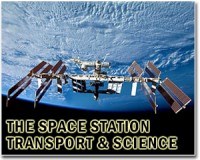 |
Washington (AFP) Aug 1, 2010 A failure of the cooling system on the International Space Station forced astronauts to re-route power Sunday as NASA planned emergency spacewalks to fix the problem. One of two cooling loops shut down Saturday night, triggering alarms throughout the orbiting station, which is manned by three Russian and three American astronauts. NASA said the crew is not in any danger, but an attempt overnight to close the circuit breaker and restart the pump module that feeds the vital ammonia to the cooling system failed. Astronauts closed down two of the gyroscopes that position the station as they re-routed power from the Destiny Laboratory research module to keep the temperature system stable. One gyroscope was later put back on line. "The station is in a stable configuration with most systems receiving cooling and many systems operating with redundancy following the installation of jumper cables from the Destiny Lab's power system overnight," the US space agency said. "The crew is not in any danger and is monitoring systems and relaxing on an otherwise off duty day," the statement added. "Temperatures on the main bus switching units, which route power to various systems, are a little higher than normal, but well within normal parameters and are stable." Despite the reassurances, NASA approved a preliminary plan for two US astronauts, Doug Wheelock and Tracy Caldwell Dyson, to conduct a spacewalk to fetch a replacement pump module. "The most likely scenario would call for an initial spacewalk no earlier than Thursday by Wheelock and Caldwell Dyson to replace the pump module and structurally bolt it into place on the S1 truss, with an additional spacewalk by the duo two or three days later to mate fluid and electrical connections," a statement said. According to NASA figures, without thermal controls the ISS's sun-facing side would roast at 250 degrees Fahrenheit (121 Celsius), while the outpost's dark side would plunge to some minus 250 degrees Fahrenheit (-157 Celsius). A statement posted some years ago on NASA's website suggested: "There might be a comfortable spot somewhere in the middle of the Station, but searching for it wouldn't be much fun!" Before the module can be replaced, any residual ammonia must first be pumped out of the system, according to NASA, which announced a briefing at 2000 GMT Monday to discuss the latest developments. Wheelock and Caldwell Dyson had already been scheduled for a spacewalk on Thursday to do routine maintenance work. The ISS, which orbits 350 kilometers (220 miles) above Earth, is a sophisticated platform for scientific experiments, helping test the effects of long-term space travel on humans, a must for any trip to distant Mars. NASA has set November 1 for the launch of space shuttle Discovery's mission to the space station. Endeavour will blast off on February 26 on the final shuttle mission to the station before the space shuttle program is phased out. Once the program ends, the United States will rely on Russia's Soyuz rockets to carry its astronauts to the space station until a commercial US launcher can be developed. That is scheduled for 2015.
Share This Article With Planet Earth
Related Links Station at NASA Station and More at Roscosmos S.P. Korolev RSC Energia Watch NASA TV via Space.TV Space Station News at Space-Travel.Com
 Space walk successful despite lost parts
Space walk successful despite lost partsHouston (UPI) Jul 27, 2010 Two Russian cosmonauts on the International Space Station have successfully completed a space walk despite losing a tool and a washer, U.S. controllers said. Fyodor Yurchikhin and Mikhail Kornienko spent almost 7 hours outside the orbiting facility replacing a broken camera and installing cables on a Russian module to help outfit it as a new docking port, SPACE.com reported. At o ... read more |
|
| The content herein, unless otherwise known to be public domain, are Copyright 1995-2010 - SpaceDaily. AFP and UPI Wire Stories are copyright Agence France-Presse and United Press International. ESA Portal Reports are copyright European Space Agency. All NASA sourced material is public domain. Additional copyrights may apply in whole or part to other bona fide parties. Advertising does not imply endorsement,agreement or approval of any opinions, statements or information provided by SpaceDaily on any Web page published or hosted by SpaceDaily. Privacy Statement |